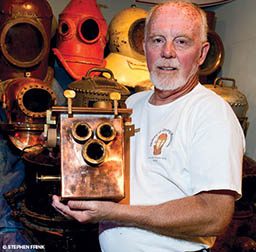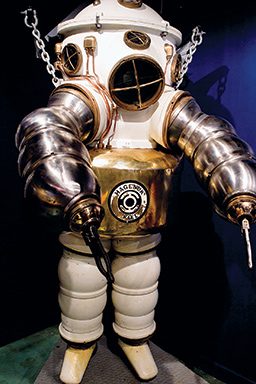There is no doubt that one of the most popular dive destinations in the United States is the Florida Keys. But for visiting divers, there is another treasure located in picturesque Islamorada, and it requires no certification card to enjoy it. The Florida Keys History of Diving Museum is a must-see for those visiting the area.

The museum is the brainchild of Dr. Joe Bauer and his wife, Dr. Sally Bauer. Their passion for diving is obvious when you see the extensive collection of archives and diving gear from all over the world. Fortunately, Joe was able to see the realization of his dream and lifelong passion for diving history before his death in 2007.
After viewing a short orientation video, visitors experience the “Timeline of Diving,” beginning more than 4,000 years ago with early breath-hold divers and early diving contraptions, and continuing all the way through early scuba. Visitors then see how commercial applications led to the development of equipment with recreational applications, such as the advent of open-bottom helmets making the experience of breathing underwater far more accessible.
Of course, no diving museum would be complete without an exhibit on treasure diving. Long before Mel Fisher was known as the treasure hunter in the Keys, Art McKee was established in Islamorada and doing extensive exploration on the wrecks of the 1733 fleet of New Spain treasure ships that were destroyed in a hurricane. McKee even had a treasure museum in the 1960s and ’70s to display his various archaeological (and treasure) discoveries. Visitors to the History of Diving Museum can learn more about McKee and see a typical 16th-century iron treasure chest.

A marquee element of the museum is the “Parade of Nations” exhibit, which features an audiovisual presentation narrated by the museum’s founder. It highlights the hard-hat diving helmets from every country ever to produce a diving helmet. It’s hard to appreciate what an amazing and rare sight it is to see all of these rare helmets on display.
More exhibits include the advances in underwater cameras, subsurface lighting and communications, and the use of mixed gases for deep-saturation diving. There are displays of the development of scuba equipment from as early as 1928. Two-hose regulators and military rebreathers are displayed along with the early sport-diving equipment from the 1950s. There even are several one-atmosphere diving suits on display, illustrating some of the devices that have allowed mankind to explore remarkable depths.
The History of Diving Museum has interactive exhibits for all ages. Plan to spend about 2-3 hours to allow enough time to immerse yourself in all the exhibits. The museum is a 501©(3) nonprofit corporation with hopes of expanding. The History of Diving Museum is easy to find; it is located on U.S. Highway 1 at Mile Marker 83 on the bay side (west). Just look for the building with all the marine life painted on the side.
To learn more about the museum, visit Diving Museum.
© Alert Diver — Q4 Fall 2010